Temperature Compensation for Chromatic Stability of RGBW LEDs in Automotive Interior Lighting
Abstract
1. Introduction
2. Related Works
3. Materials and Methods
3.1. Theoretical Background
3.1.1. Colorimetry
CIE Chromaticity Diagram
Color Mixing
Color Rendering Index
3.1.2. Temperature Dependence of LEDs
3.2. Algorithm Description
3.2.1. RGB Temperature Compensation Algorithm
LEDs Characterization
LEDs Calibration
Core LEDs Compensation Algorithm
3.2.2. Extension to RGBW Algorithm
3.3. Experimental Setup
3.3.1. Hardware
3.3.2. Software
3.3.3. Measuring Instruments and Calibration Procedures
- Vötsch VT 7004 thermal chamber: it is a compact climatic chamber, engineered for precise environmental testing, offering an internal volume of 37 L. It is capable of reaching temperatures as low as −70 °C, with a maximum of 180 °C [37].
- Keithley 2110 digital multimeter and RS PRO RS52: the thermal chamber internal temperature may differ from that of the LED junctions, which is the quantity of true interest, as it is ultimately the one to be estimated. For this reason, an additional thermometer, namely a K-type thermocouple, is required to be positioned in close proximity to the LED to measure the junction temperature as precisely as possible.
- Ocean Optics SR4 spectrometer: the instrument employed herein is capable of analyzing specifically the visible spectrum and a portion of the near-infrared region (NIR), as its declared range extends from 345 to 1054 nm.
- Calibration procedure: the goal of the calibration phase is to establish, for each LED, the luminous flux and chromaticity coordinates at a reference temperature. Additionally, the forward voltage () calibration is performed automatically by the algorithm at startup, which requires the system to be stabilized at 25 °C. Alternatively, it is possible to hardcode a previously acquired calibration curve, avoiding the need to repeat this step at every power-up, since it is redundant once properly acquired.
- Testing and validation procedure: the algorithm validation procedure is intended to verify its operation under real operating conditions, specifically with respect to its ability to maintain color constancy as the ambient and junction temperatures change. This means, in practice, ensuring that the chromaticity of the emitted light, as measured with the spectrometer, remains effectively stable over temperature. More precisely, the color output must not deviate by more than in the color space from the target point across the entire thermal range being tested.
3.3.4. Variation for RGBW Setup
4. Experimental Results
4.1. RGB Algorithm
4.2. RGBW Algorithm
5. Discussion
6. Conclusions
Author Contributions
Funding
Institutional Review Board Statement
Informed Consent Statement
Data Availability Statement
Conflicts of Interest
References
- Valeo. Automotive Interior Lighting: From Static to On-Surface Projection. Available online: https://www.valeo.com/en/automotive-interior-lighting-from-static-to-on-surface-projection/ (accessed on 20 August 2025).
- Tao, L.; Liu, M. Biomechanical optimization of RGB LED systems: Temperature prediction model and optical compensation algorithm based on built-in constant current source chip. Mol. Cell. Biomech. 2025, 22, 800. [Google Scholar] [CrossRef]
- Hong, L.; Liu, M. An Improved sRGB Optical Algorithm Considering Thermal Effects and Adaptability for Low-Cost Automotive-Grade Dedicated LED Chips. World Electr. Veh. J. 2025, 16, 235. [Google Scholar] [CrossRef]
- Ren, H.; Li, S.; Sun, R.; Su, Z. Study on LED Color Mixing for Stage Lighting Based on Locus Fitting of Blackbody. In Proceedings of the 2018 IEEE 3rd International Conference on Cloud Computing and Internet of Things (CCIOT), Dalian, China, 20–21 October 2018; pp. 177–181. [Google Scholar] [CrossRef]
- Merenda, M.; Porcaro, C.; Della Corte, F.G. LED junction temperature prediction using machine learning techniques. In Proceedings of the 2020 IEEE 20th Mediterranean Electrotechnical Conference (MELECON), Palermo, Italy, 16–18 June 2020; pp. 207–211. [Google Scholar] [CrossRef]
- Qu, X.; Wong, S.C.; Tse, C.K. Color Control System for RGB LED Light Sources Using Junction Temperature Measurement. In Proceedings of the IECON 2007—33rd Annual Conference of the IEEE Industrial Electronics Society, Taipei, Taiwan, 5–8 November 2007. [Google Scholar] [CrossRef]
- Liu, X.; Jiang, C.; Liu, X.; Liu, Z.; Min, H.; Zhuang, Z. RGBW LED mixing temperature compensation method with high output consistency. Opt. Laser Technol. 2024, 171, 110440. [Google Scholar] [CrossRef]
- Kalustova, D.; Kornaga, V.; Rybalochka, A.; Yu, Y.; Valyukh, S. Color temperature tunable RGBW cluster with optimize color rendering and efficacy. Opt. Eng. 2023, 62, 045102. [Google Scholar] [CrossRef]
- Blankenbach, K.; Hertlein, F.; Hoffmann, S. Advances in automotive interior lighting concerning new LED approach and optical performance. J. Soc. Inf. Disp. 2020, 28, 655–667. [Google Scholar] [CrossRef]
- Kim, T.; Choi, K.; Suk, H.J. Affective responses to chromatic ambient light in a vehicle. arXiv 2022, arXiv:2209.10761. [Google Scholar] [CrossRef]
- Martínez-Pérez, J.; Martínez-Olmos, A.; Santaella, J.; Escobedo, P.; López-Ruiz, N.; Carvajal, M. LED biasing scheme with thermal compensation for automotive industry applications. Results Eng. 2024, 21, 101699. [Google Scholar] [CrossRef]
- Qu, X.; Wong, S.C.; Tse, C.K. Temperature Measurement Technique for Stabilizing the Light Output of RGB LED Lamps. IEEE Trans. Instrum. Meas. 2010, 59, 661–670. [Google Scholar] [CrossRef]
- Shahila, N.A.; Abbasi, M.I.; Khang, A.W.Y.; Poh, C.C.K.; Yeow, L.T. Preliminary Study on using Advanced PWM Control Techniques for Automotive LED Drivers - Temperature Compensation. J. Phys. Conf. Ser. 2025, 3020, 012003. [Google Scholar] [CrossRef]
- Han, Z.; Zhang, Z.; Liu, K.; Li, Y.; Xiao, W.; Liu, J.; Zhu, X.; Zheng, C.; Wu, Q. Spectral optimization of trichromatic white LEDs based on age of lighting user and application scene. Opt. Express 2023, 31, 11624–11632. [Google Scholar] [CrossRef] [PubMed]
- Li, Z.; Liu, J.; Pan, Y.; Cheng, Z.; Si, G.; Fang, Y. Self-adaptive LED spectrum-tunable light source with high output irradiance and uniformity. Opt. Commun. 2024, 569, 130835. [Google Scholar] [CrossRef]
- Zhang, F.; Xu, H.; Wang, Z. Spectral design methods for multi-channel LED light sources based on differential evolution. Appl. Opt. 2016, 55, 7771–7781. [Google Scholar] [CrossRef] [PubMed]
- Yoshi, O. CIE Fundamentals for Color Measurements. In Proceedings of the 2000 International Conference on Digital Printing Technologies (IIS&Ts NIP16), Vancouver, BC, Canada, 15–20 October 2020; pp. 541–545. [Google Scholar]
- Planck, M. The theory of heat radiation. Entropie 1900, 144, 164. [Google Scholar]
- Wikipedia. Planckian Locus—Wikipedia. Available online: https://en.wikipedia.org/wiki/Planckian_locus (accessed on 20 August 2025).
- Luna, R. Round White Plate of Peaches. Unsplash. 2018. Available online: https://unsplash.com/photos/round-white-plate-of-peaches-upqRGMhPUC0 (accessed on 20 August 2025).
- Schubert, E.F. Light-Emitting Diodes, 2nd ed.; Cambridge University: Cambridge, UK, 2006. [Google Scholar]
- Wyszecki, G.; Stiles, W.S. Color Science: Concepts and Methods, Quantitative Data and Formulae; John Wiley & Sons: Hoboken, NJ, USA, 2000. [Google Scholar]
- Nichia. Nichia Products Website: NSSM313A-V1. Available online: https://led-ld.nichia.co.jp/en/product/led_product_data.html?type=NSSM313A-V1&kbn=0 (accessed on 20 August 2025).
- Nichia. NSSM313AT-V1 RGB LED Datasheet. 2022. Available online: https://led-ld.nichia.co.jp/api/data/spec/led/NSSM313AT-V1-E(6501G).pdf (accessed on 20 August 2025).
- Xu, H.; Hou, X.; Chen, L.; Mei, Y.; Zhang, B. Optical Properties of InGaN/GaN QW with the Same Well-Plus-Barrier Thickness. Crystals 2022, 12, 114. [Google Scholar] [CrossRef]
- Vainshtein, I.; Zatsepin, A.; Kortov, V. Applicability of the empirical Varshni relation for the temperature dependence of the width of the band gap. Phys. Solid State 1999, 41, 905–908. [Google Scholar] [CrossRef]
- Varshni, Y. Temperature dependence of the energy gap in semiconductors. Physica 1967, 34, 149–154. [Google Scholar] [CrossRef]
- Kasap, S.O. Optoelectronics and Photonics; Pearson Education: London, UK, 2013; Volume 218. [Google Scholar]
- Infineon Technologies AG. TLD4020-3ET—Programmable 3-ch LIN RGB Driver. 2025. Available online: https://www.infineon.com/part/TLD4020-3ET (accessed on 20 August 2025).
- Infineon Technologies AG. LITIX™ Interior—LITIX™ Interior LED Drivers for Automotive Ambient Lighting. 2025. Available online: https://www.infineon.com/products/power/led-driver-ics/litix-automotive/litix-interior (accessed on 20 August 2025).
- Infineon Technologies AG. LITIX™—Automotive LED Driver IC. 2025. Available online: https://www.infineon.com/products/power/led-driver-ics/litix-automotive (accessed on 20 August 2025).
- Arm® Cortex®-M23. 2025. Available online: https://developer.arm.com/Processors/Cortex-M23 (accessed on 20 August 2025).
- Infineon. TLD4020-3ET Product Overview. Infineon Technologies AG. 2025. Available online: https://www.infineon.com/assets/row/public/documents/10/41/infineon-infineon-tld4020-3et-product-overview-v1-00-e-productoverview-en.pdf (accessed on 20 August 2025).
- Nichia. Nichia Website. Available online: https://www.nichia.co.jp/en/ (accessed on 20 August 2025).
- Nichia. Nichia Products Website: NFSW123F. Available online: https://led-ld.nichia.co.jp/en/product/led_product_data.html?type=NFSW123F&kbn=0 (accessed on 20 August 2025).
- Ocean Optics Inc. OceanView 2.0 Software. Available online: https://www.oceanoptics.com/software/oceanview/ (accessed on 20 August 2025).
- Vötsch. Vötsch VT 7004 Operating Instructions. Vötsch Industrietechnik GmbH. 1996. Available online: https://lampz.tugraz.at/~hadley/semi/ch9/instruments/VT4002/VT4002_climate_chamber.pdf (accessed on 20 August 2025).
- Hegedüs, J.; Hantos, G.; Poppe, A. Lifetime Modelling Issues of Power Light Emitting Diodes. Energies 2020, 13, 3370. [Google Scholar] [CrossRef]


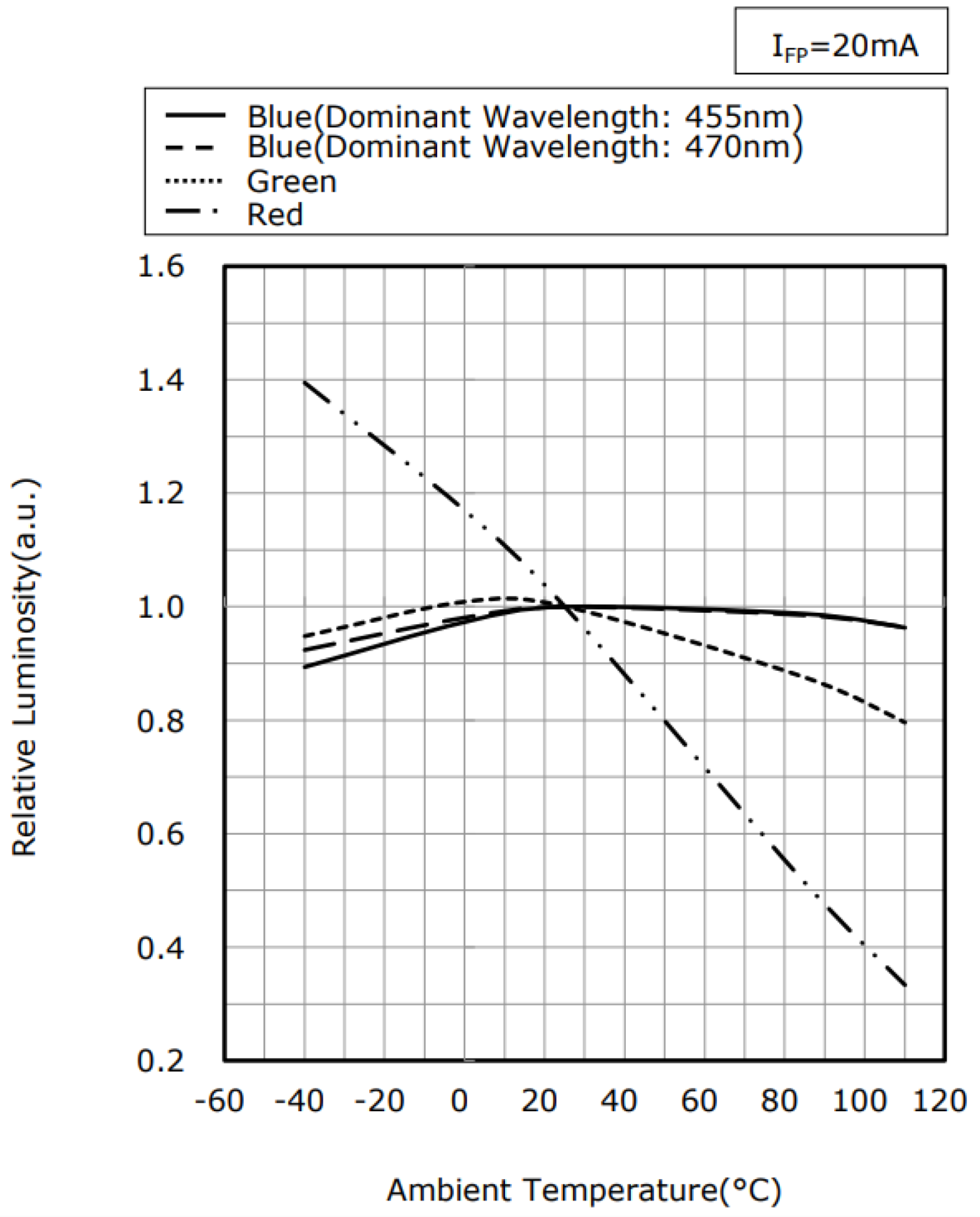

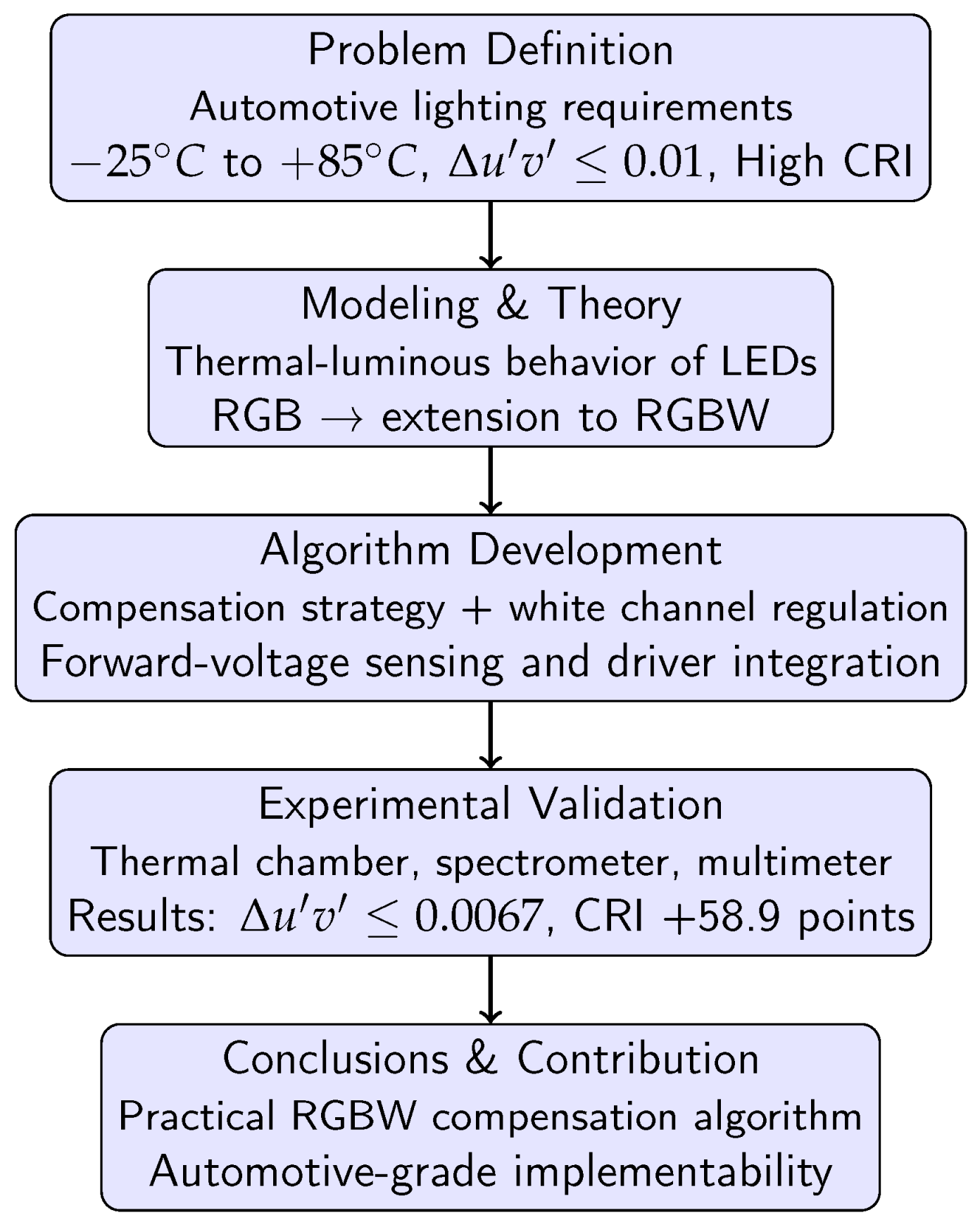
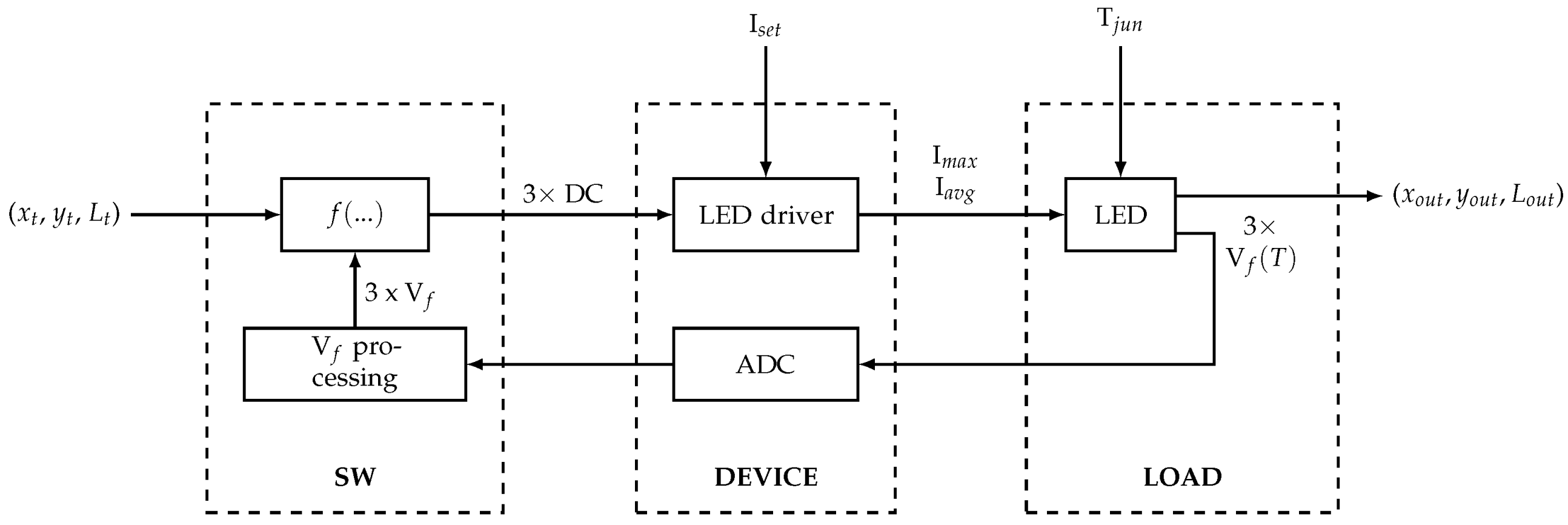

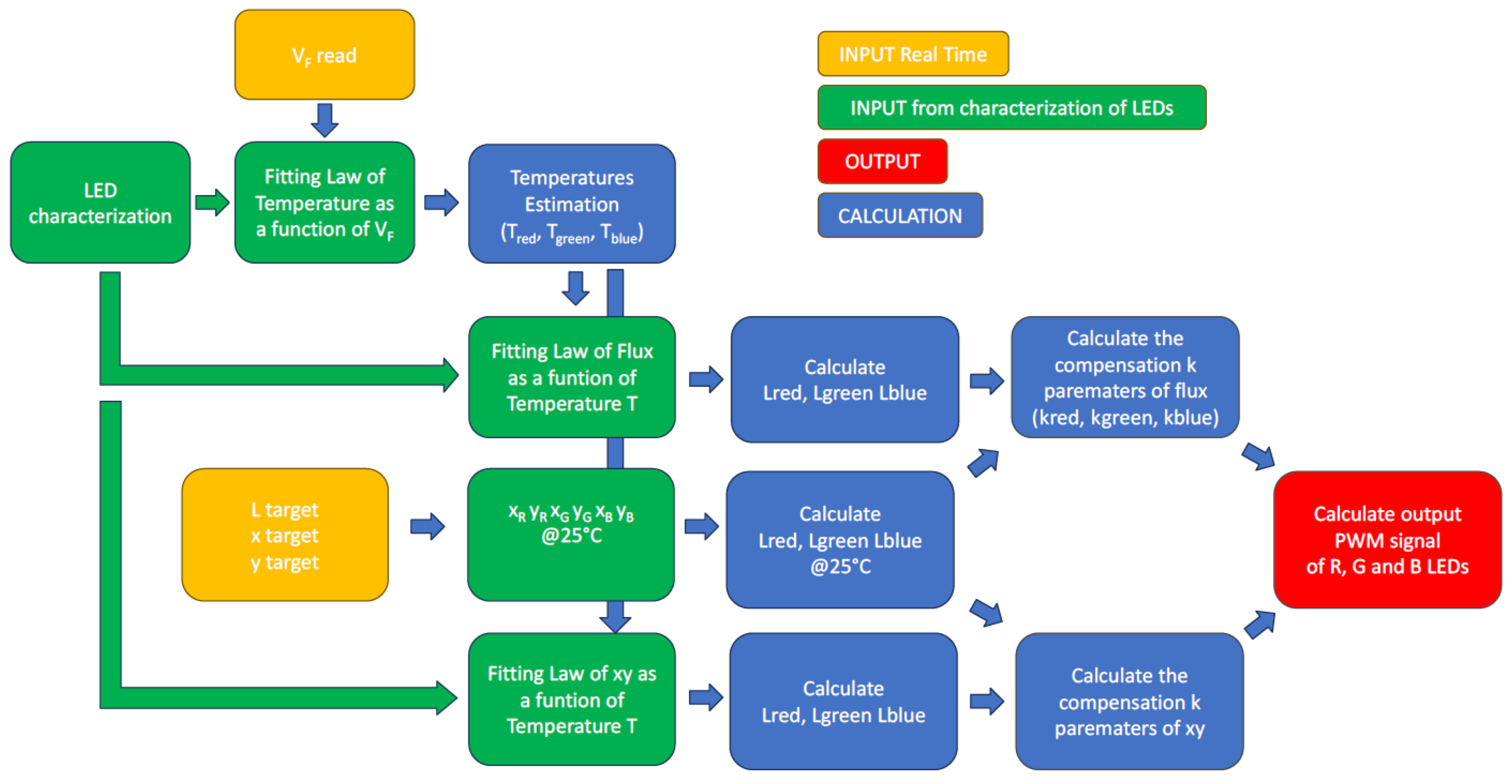

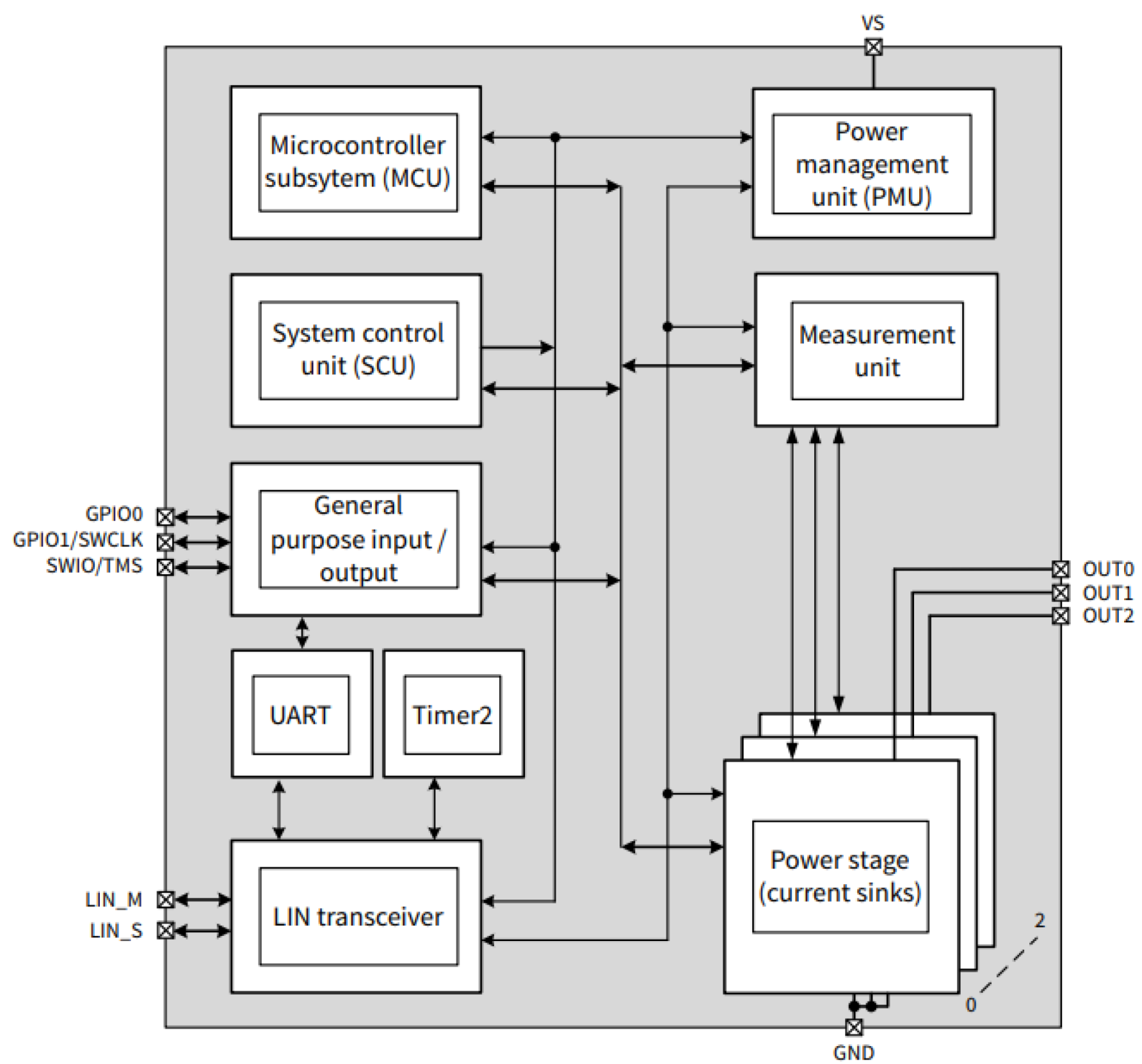
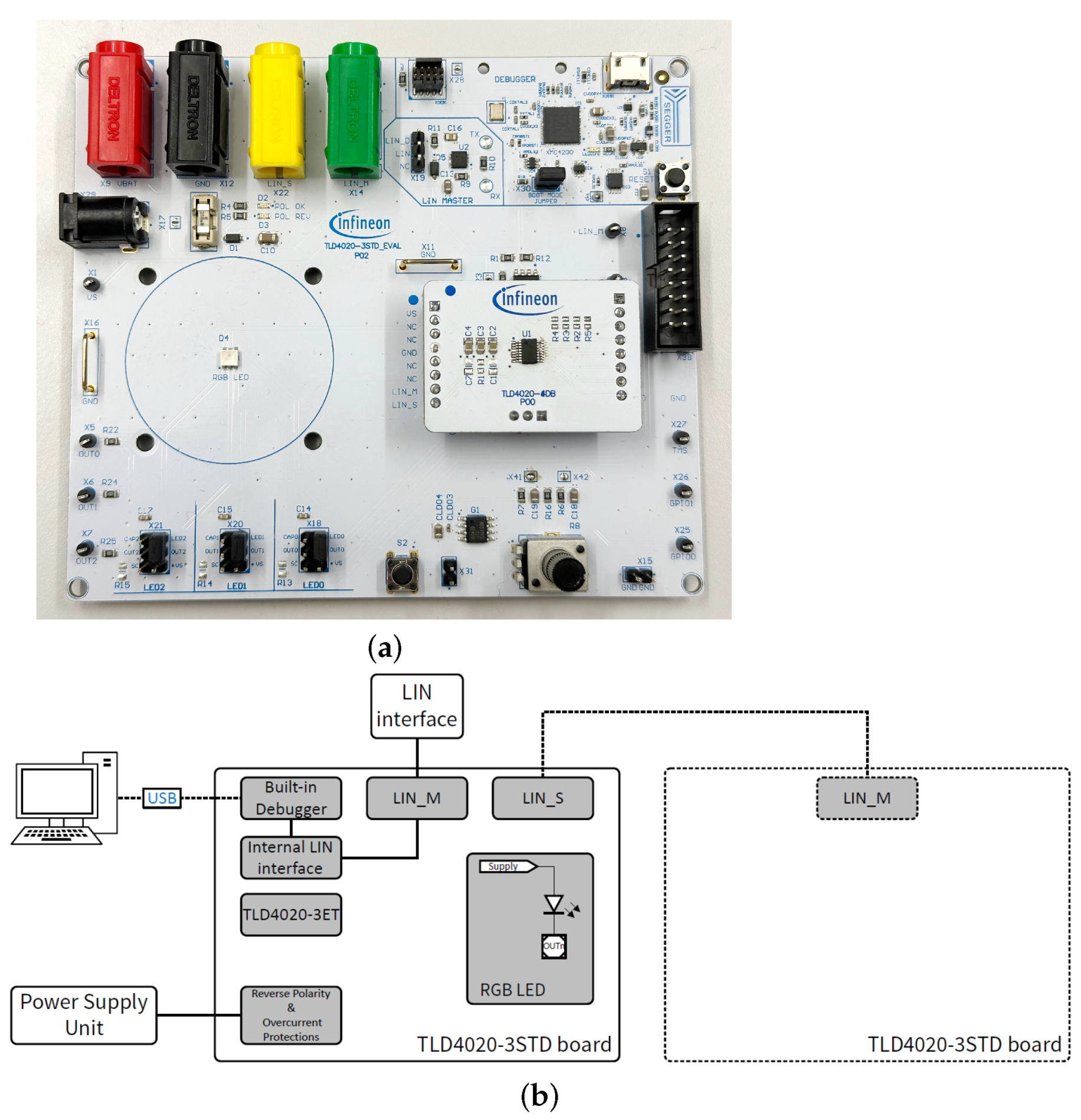
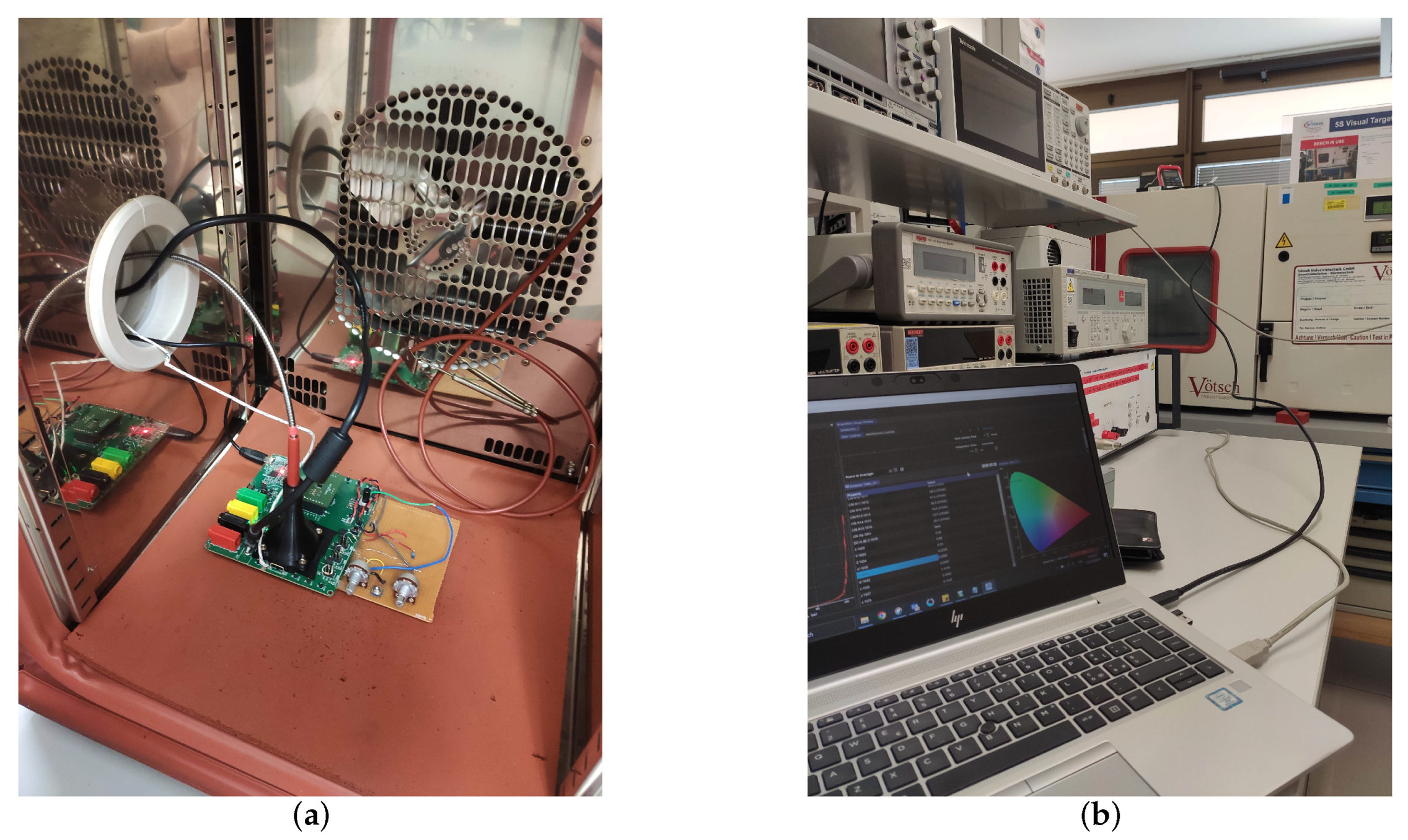

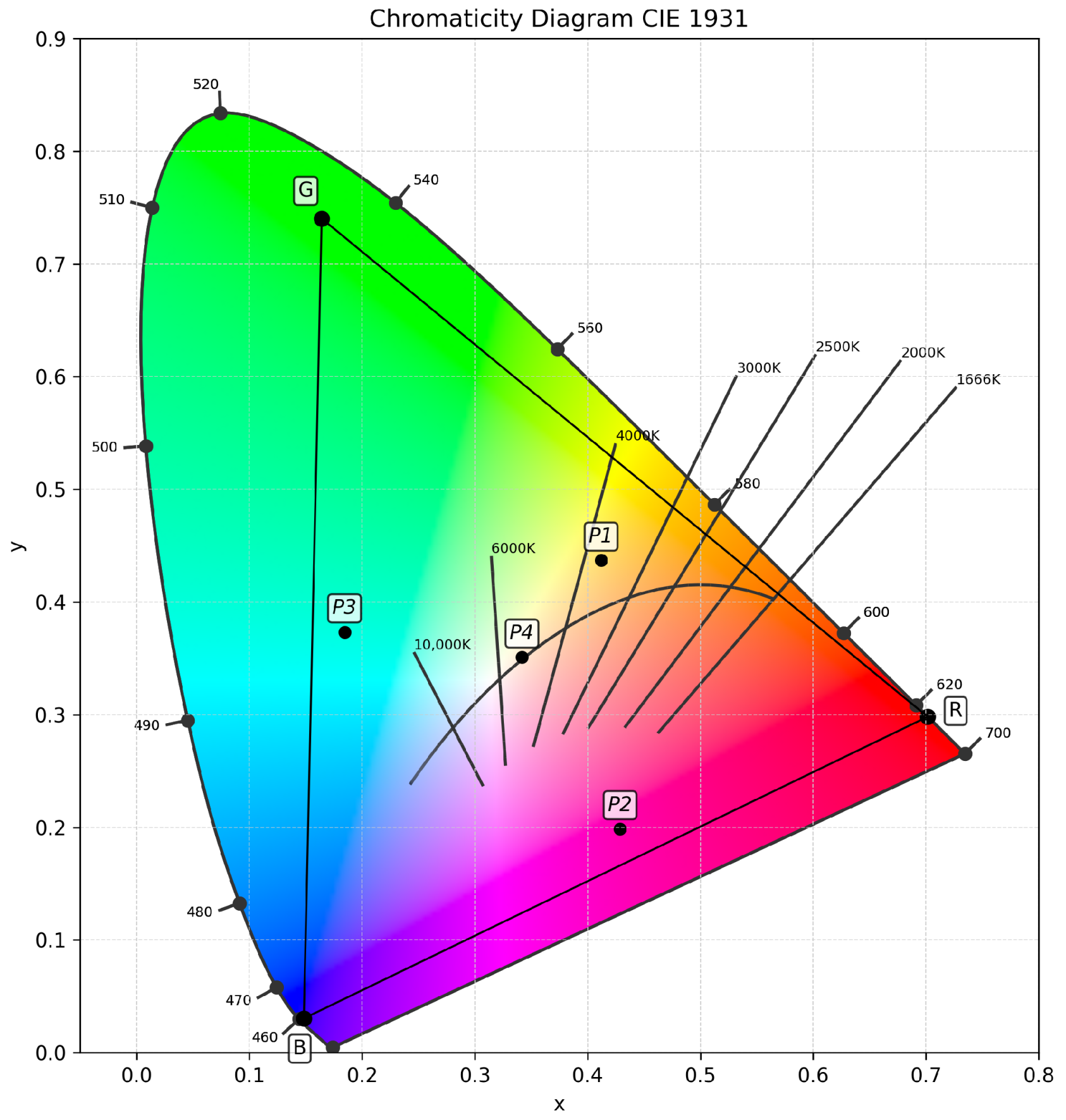
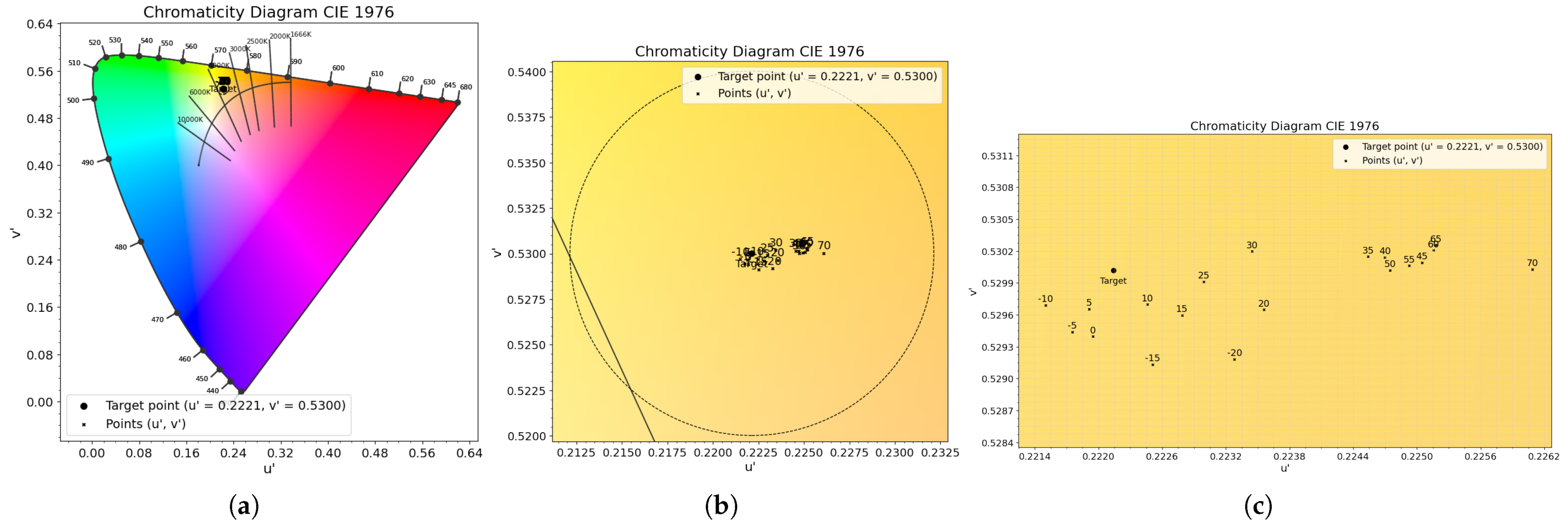

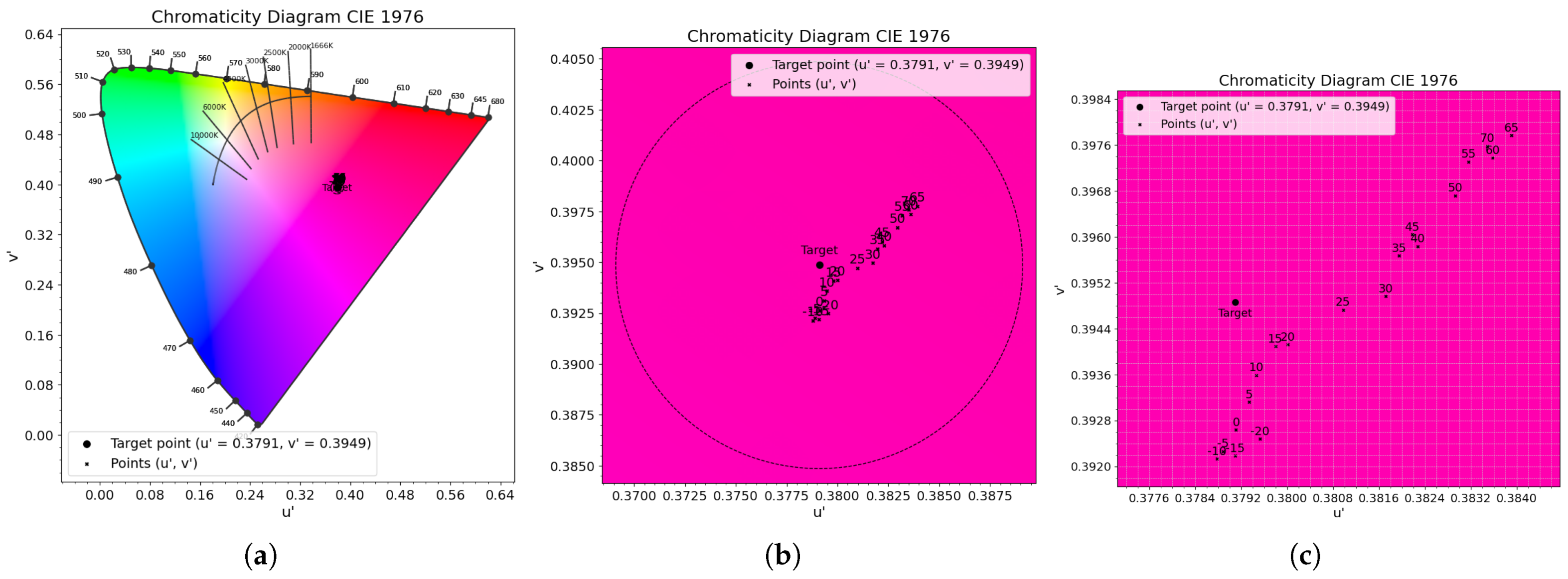
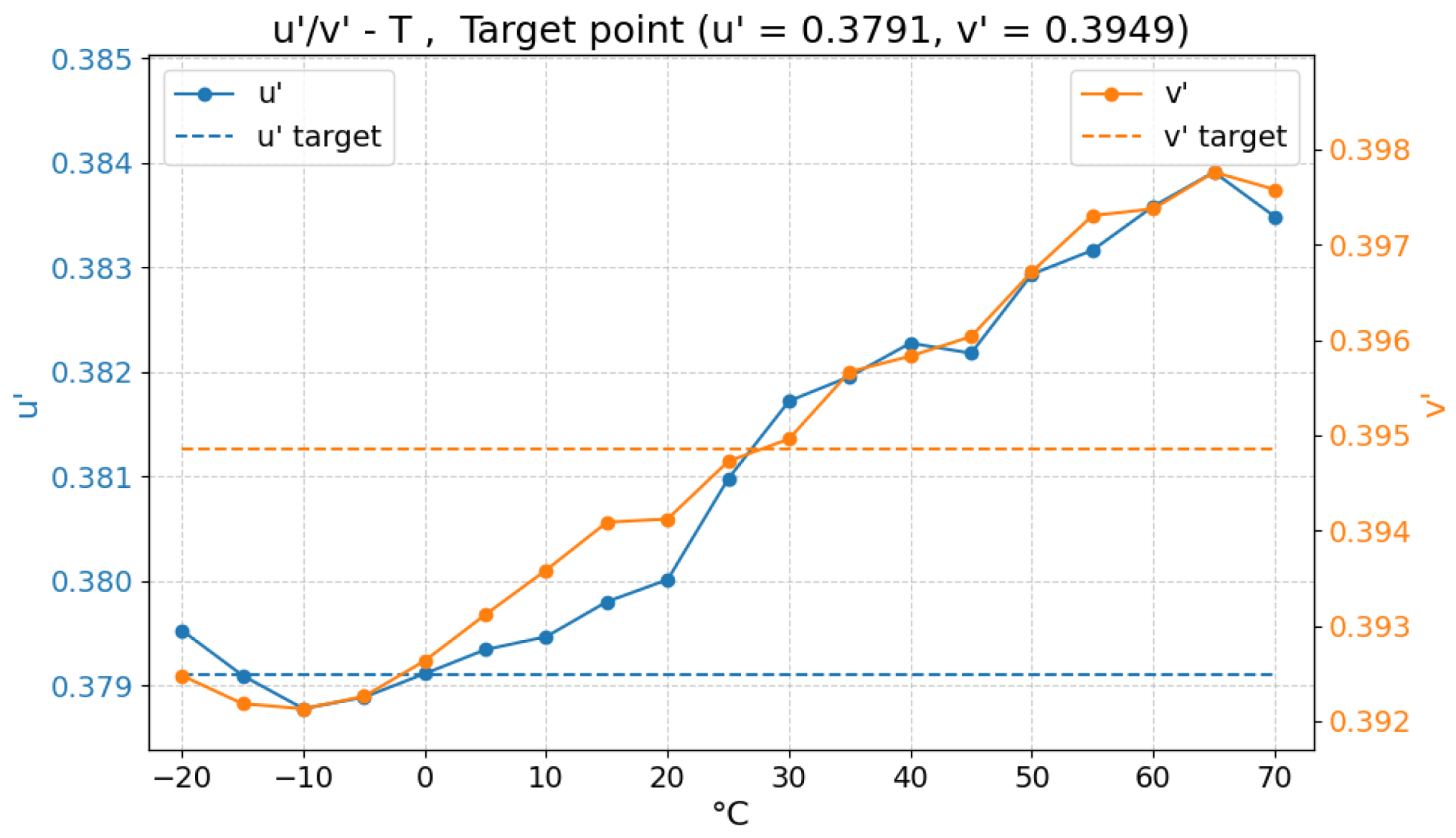
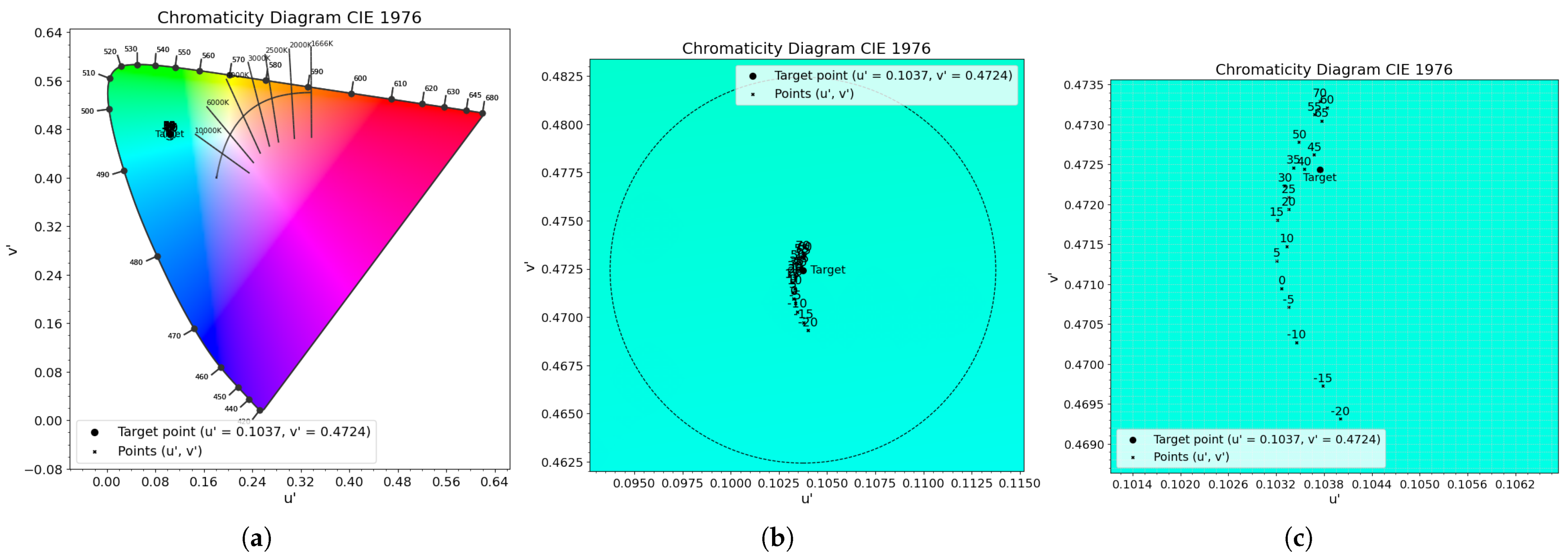
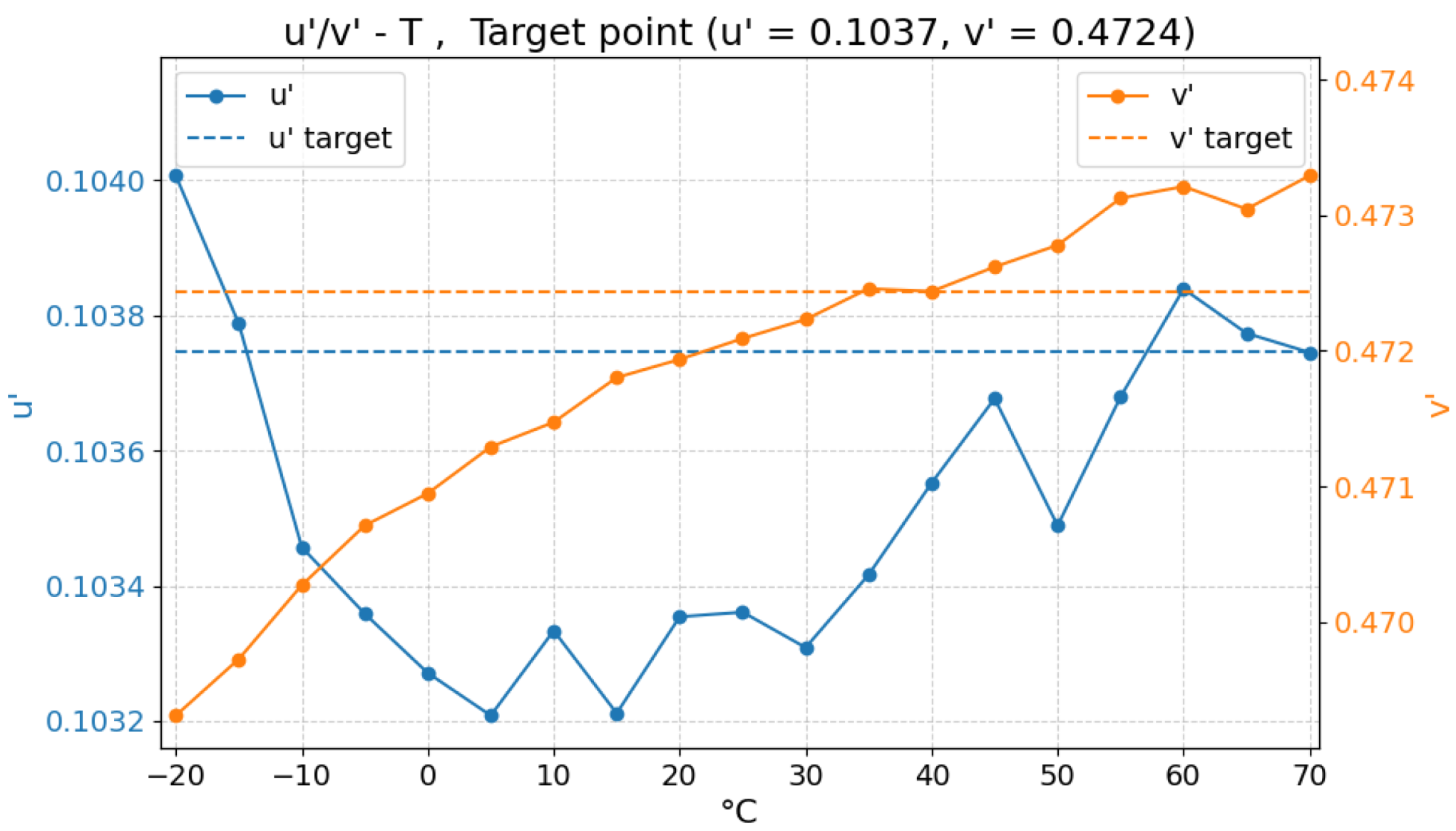
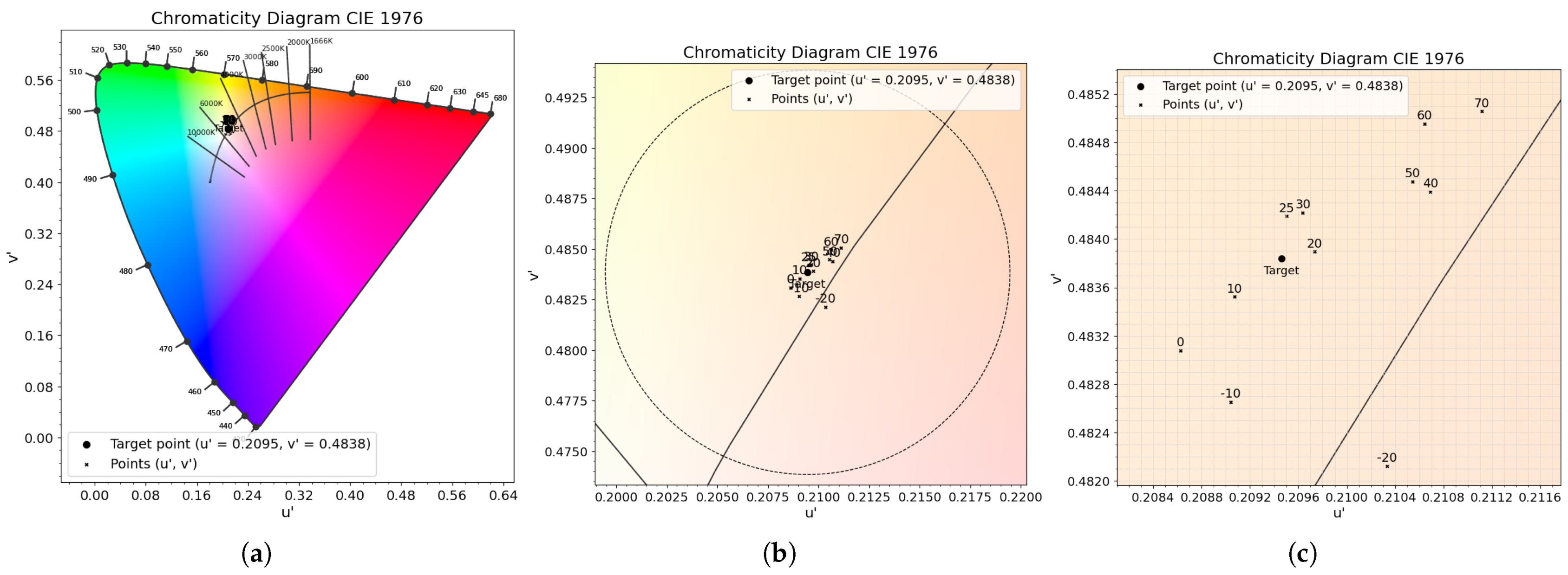

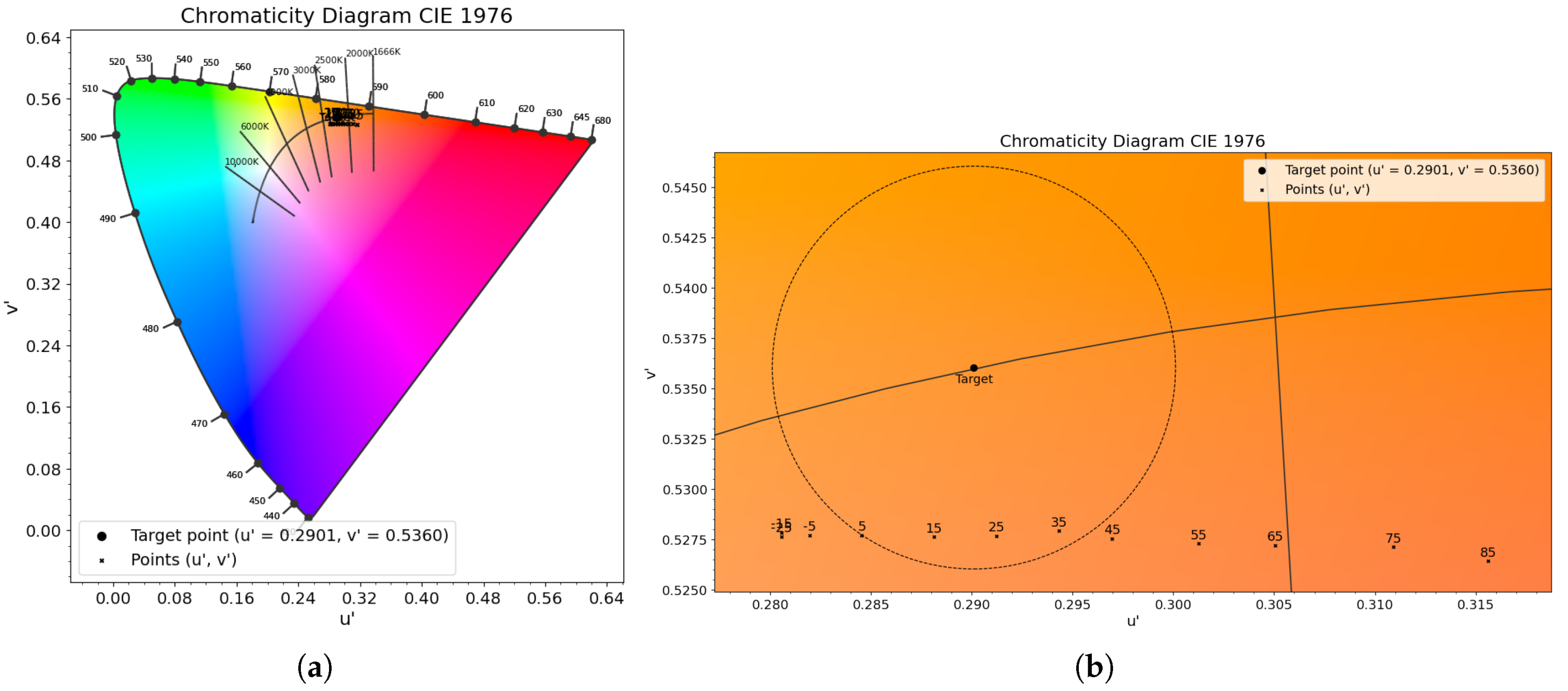
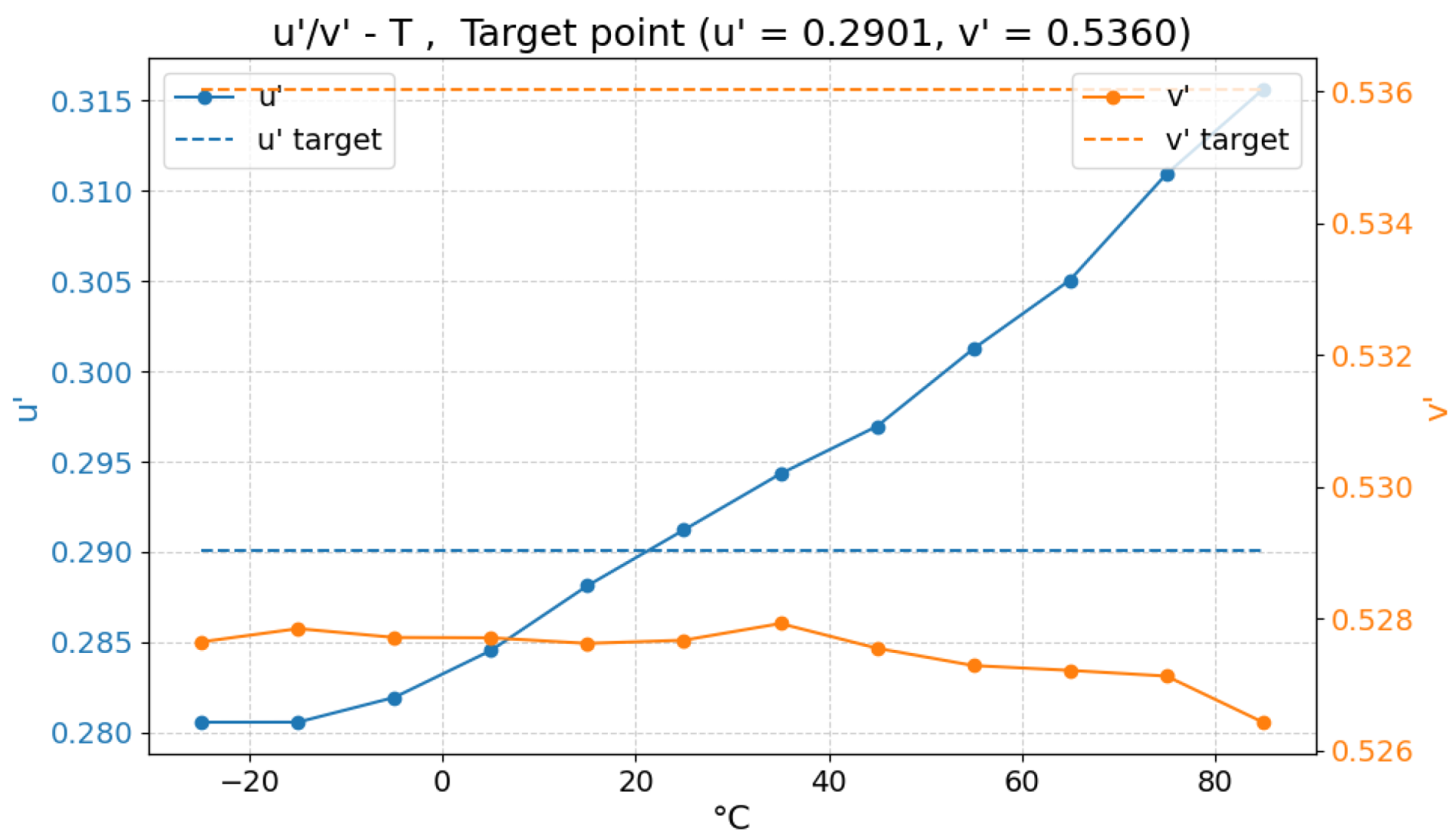



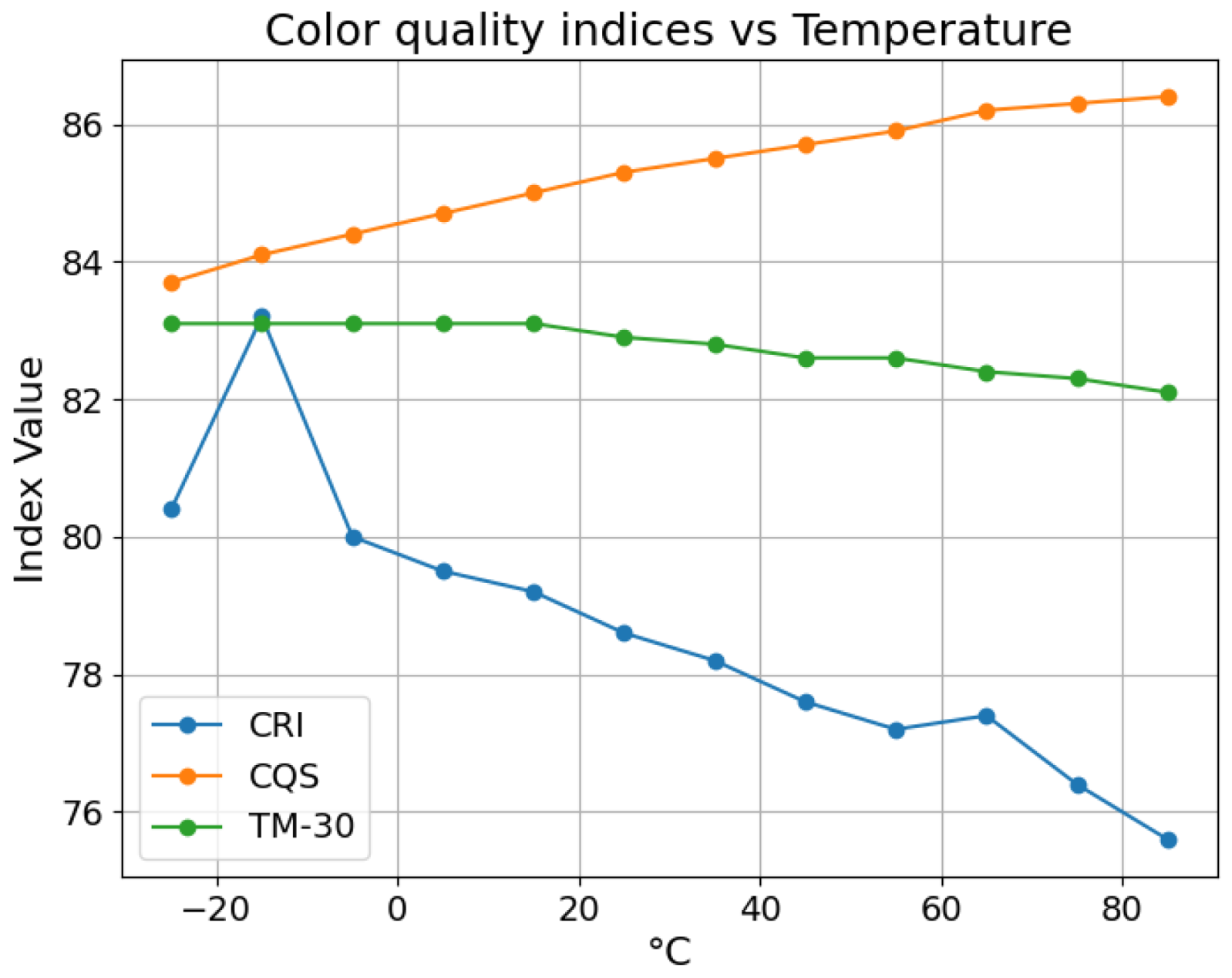
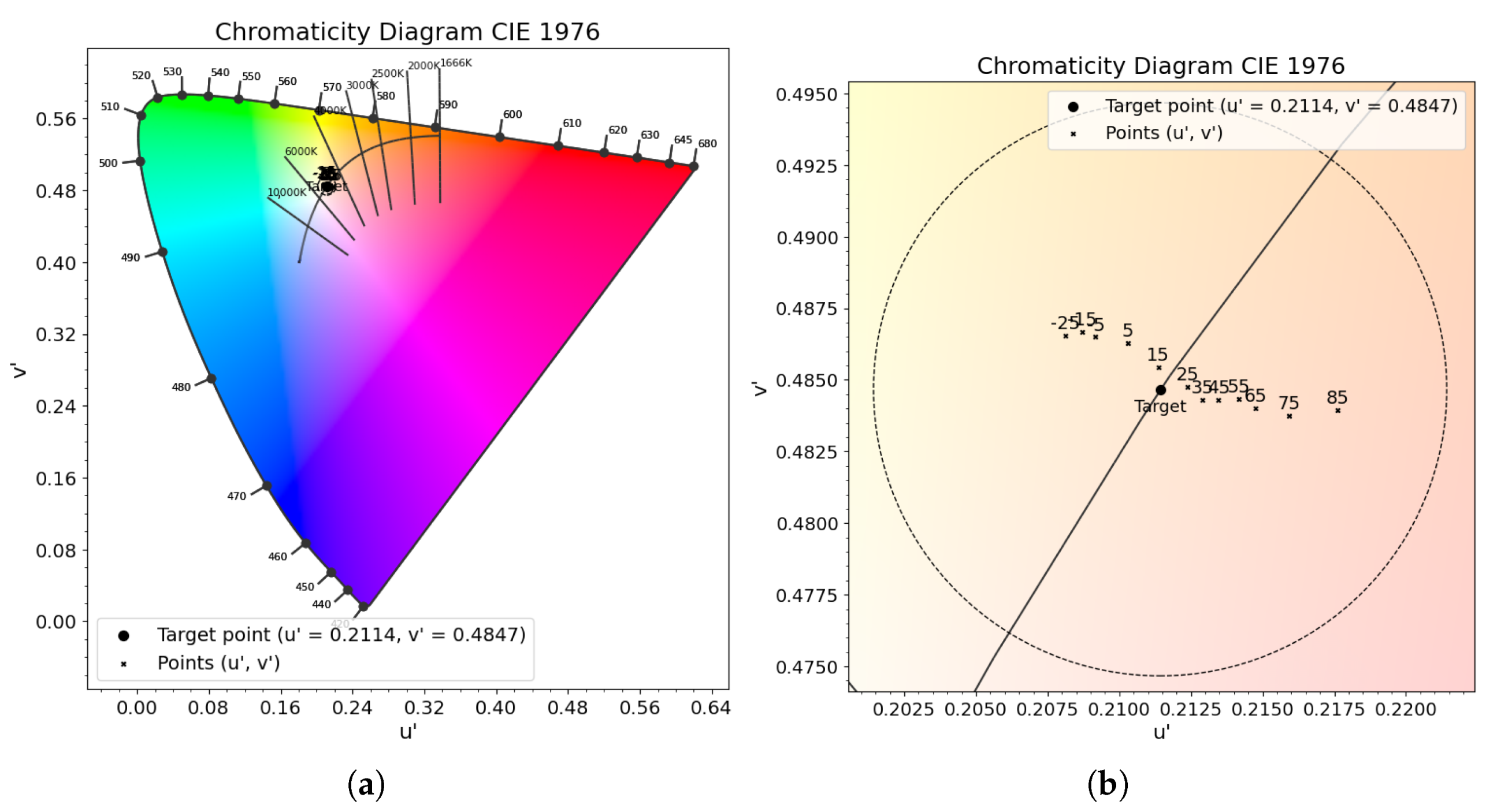


| Author | Method | Pros | Cons |
|---|---|---|---|
| Hong and Liu [3] | Thermal model based on Fourier temperature–power prediction and sRGB compensation algorithm. | No external temperature sensors needed. Low chromaticity deviation (). | Limited to RGB. Requires physical parameters (, ) that must be measured for each LED type and vary with PCB layout and chip design. |
| Tao and Liu [2] | Temperature prediction using internal current source behavior and optical compensation via precomputed LUT on chip. | No external temperature sensor needed. Low chromaticity deviation (). | Limited to RGB. Temperature estimation accuracy depends on the thermal behavior of the specific driver chip. Requires empirical calibration for each IC. |
| Qu et al. [12] | Junction temperature estimated from forward voltage. Optical compensation via tristimulus modeling based on forward voltage measurements. | No temperature sensors required. Low chromaticity deviation (). | Limited to RGB. Linear model between temperature and optical response. |
| Shahila et al. [13] | Adaptive real-time temperature-compensated PWM control, using adaptive frequency and phase adjustment. | Reduced thermal stress and prolonged LED lifespan. | Limited to RGB. Requires an on-board temperature sensor. Phase control adds system complexity. |
| Proposed method | Forward-voltage-based junction temperature estimation. LED characterization-based correction. RGBW compensation. | No temperature sensors needed. Supports RGBW (higher CRI). Low chromaticity deviation for RGB (, ). | Requires characterization and calibration for each different LED. |
| Point | x | y | u’ | v’ |
|---|---|---|---|---|
| P1 | 0.4120 | 0.4369 | 0.2221 | 0.5300 |
| P2 | 0.4288 | 0.1985 | 0.3791 | 0.3949 |
| P3 | 0.1844 | 0.3732 | 0.1037 | 0.4724 |
| P4 | 0.3418 | 0.3509 | 0.2095 | 0.4838 |
| CCT | x | y | u’ | v’ |
|---|---|---|---|---|
| 2220 K | 0.5056 | 0.4152 | 0.2901 | 0.5360 |
| 4000 K | 0.3804 | 0.3767 | 0.2251 | 0.5015 |
| 5000 K | 0.3451 | 0.3516 | 0.2114 | 0.4847 |
| CCT | Max | CRI RGBW (25 °C) | CRI RGB (25 °C) | ΔCRI |
|---|---|---|---|---|
| 2200 K | 0.0272 | 31.6 | 3.7 | +27.9 |
| 4000 K | 0.0067 | 78.6 | 19.7 | +58.9 |
| 5000 K | 0.0062 | 77.6 | 23.5 | +54.1 |
Disclaimer/Publisher’s Note: The statements, opinions and data contained in all publications are solely those of the individual author(s) and contributor(s) and not of MDPI and/or the editor(s). MDPI and/or the editor(s) disclaim responsibility for any injury to people or property resulting from any ideas, methods, instructions or products referred to in the content. |
© 2025 by the authors. Licensee MDPI, Basel, Switzerland. This article is an open access article distributed under the terms and conditions of the Creative Commons Attribution (CC BY) license (https://creativecommons.org/licenses/by/4.0/).
Share and Cite
Rapaccini, D.; Falaschetti, L.; Lissandron, S.; Conti, M.; Orcioni, S.; Morici, A. Temperature Compensation for Chromatic Stability of RGBW LEDs in Automotive Interior Lighting. Electronics 2025, 14, 3451. https://doi.org/10.3390/electronics14173451
Rapaccini D, Falaschetti L, Lissandron S, Conti M, Orcioni S, Morici A. Temperature Compensation for Chromatic Stability of RGBW LEDs in Automotive Interior Lighting. Electronics. 2025; 14(17):3451. https://doi.org/10.3390/electronics14173451
Chicago/Turabian StyleRapaccini, Dennis, Laura Falaschetti, Stefano Lissandron, Massimo Conti, Simone Orcioni, and Andrea Morici. 2025. "Temperature Compensation for Chromatic Stability of RGBW LEDs in Automotive Interior Lighting" Electronics 14, no. 17: 3451. https://doi.org/10.3390/electronics14173451
APA StyleRapaccini, D., Falaschetti, L., Lissandron, S., Conti, M., Orcioni, S., & Morici, A. (2025). Temperature Compensation for Chromatic Stability of RGBW LEDs in Automotive Interior Lighting. Electronics, 14(17), 3451. https://doi.org/10.3390/electronics14173451










